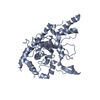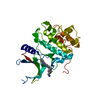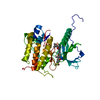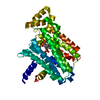+ Open data
Open data
- Basic information
Basic information
| Entry | Database: PDB / ID: 2vfj | ||||||
|---|---|---|---|---|---|---|---|
| Title | Structure of the A20 Ovarian Tumour (OTU) domain | ||||||
 Components Components | TUMOR NECROSIS FACTOR | ||||||
 Keywords Keywords |  HYDROLASE / HYDROLASE /  PHOSPHORYLATION / PHOSPHORYLATION /  CYSTEINE PROTEASE / METAL-BINDING / OVARIAN TUMOUR / CYSTEINE PROTEASE / METAL-BINDING / OVARIAN TUMOUR /  THIOL PROTEASE / DNA-BINDING / POLYMORPHISM / LYS63-LINKED / THIOL PROTEASE / DNA-BINDING / POLYMORPHISM / LYS63-LINKED /  CYTOPLASM / CYTOPLASM /  UBIQUITIN / UBIQUITIN /  ZINC-FINGER / ZINC-FINGER /  DEUBIQUITINATING ENZYME / CYTOKINE SIGNALLING / UBL CONJUGATION PATHWAY / OTU / DEUBIQUITINATING ENZYME / CYTOKINE SIGNALLING / UBL CONJUGATION PATHWAY / OTU /  ZINC / ZINC /  NF-KB / NF-KB /  NUCLEUS / NUCLEUS /  PROTEASE / PROTEASE /  APOPTOSIS APOPTOSIS | ||||||
| Function / homology |  Function and homology information Function and homology informationregulation of vascular wound healing / negative regulation of toll-like receptor 5 signaling pathway / negative regulation of nucleotide-binding oligomerization domain containing 1 signaling pathway / establishment of protein localization to vacuole / negative regulation of osteoclast proliferation / tolerance induction to lipopolysaccharide / negative regulation of CD40 signaling pathway / negative regulation of toll-like receptor 3 signaling pathway / negative regulation of B cell activation / negative regulation of nucleotide-binding oligomerization domain containing 2 signaling pathway ...regulation of vascular wound healing / negative regulation of toll-like receptor 5 signaling pathway / negative regulation of nucleotide-binding oligomerization domain containing 1 signaling pathway / establishment of protein localization to vacuole / negative regulation of osteoclast proliferation / tolerance induction to lipopolysaccharide / negative regulation of CD40 signaling pathway / negative regulation of toll-like receptor 3 signaling pathway / negative regulation of B cell activation / negative regulation of nucleotide-binding oligomerization domain containing 2 signaling pathway / negative regulation of toll-like receptor 2 signaling pathway / protein K11-linked deubiquitination / nucleotide-binding domain, leucine rich repeat containing receptor signaling pathway / negative regulation of chronic inflammatory response / negative regulation of toll-like receptor 4 signaling pathway / regulation of germinal center formation / protein K48-linked deubiquitination / B-1 B cell homeostasis / regulation of defense response to virus by host / regulation of tumor necrosis factor-mediated signaling pathway /  Transferases; Acyltransferases; Aminoacyltransferases / protein K63-linked deubiquitination / positive regulation of hepatocyte proliferation / negative regulation of bone resorption / TNFR1-induced proapoptotic signaling / negative regulation of interleukin-1 beta production / negative regulation of interleukin-2 production / K63-linked polyubiquitin modification-dependent protein binding / K63-linked deubiquitinase activity / negative regulation of NF-kappaB transcription factor activity / protein deubiquitination / negative regulation of interleukin-6 production / response to muramyl dipeptide / negative regulation of tumor necrosis factor production / positive regulation of Wnt signaling pathway / protein K48-linked ubiquitination / negative regulation of endothelial cell apoptotic process / negative regulation of canonical NF-kappaB signal transduction / negative regulation of extrinsic apoptotic signaling pathway via death domain receptors / negative regulation of protein ubiquitination / cytoskeleton organization / negative regulation of innate immune response / TNFR1-induced NF-kappa-B signaling pathway / Transferases; Acyltransferases; Aminoacyltransferases / protein K63-linked deubiquitination / positive regulation of hepatocyte proliferation / negative regulation of bone resorption / TNFR1-induced proapoptotic signaling / negative regulation of interleukin-1 beta production / negative regulation of interleukin-2 production / K63-linked polyubiquitin modification-dependent protein binding / K63-linked deubiquitinase activity / negative regulation of NF-kappaB transcription factor activity / protein deubiquitination / negative regulation of interleukin-6 production / response to muramyl dipeptide / negative regulation of tumor necrosis factor production / positive regulation of Wnt signaling pathway / protein K48-linked ubiquitination / negative regulation of endothelial cell apoptotic process / negative regulation of canonical NF-kappaB signal transduction / negative regulation of extrinsic apoptotic signaling pathway via death domain receptors / negative regulation of protein ubiquitination / cytoskeleton organization / negative regulation of innate immune response / TNFR1-induced NF-kappa-B signaling pathway /  ubiquitin binding / Negative regulators of DDX58/IFIH1 signaling / negative regulation of smooth muscle cell proliferation / Regulation of TNFR1 signaling / NOD1/2 Signaling Pathway / response to molecule of bacterial origin / ubiquitin binding / Negative regulators of DDX58/IFIH1 signaling / negative regulation of smooth muscle cell proliferation / Regulation of TNFR1 signaling / NOD1/2 Signaling Pathway / response to molecule of bacterial origin /  kinase binding / negative regulation of inflammatory response / cellular response to hydrogen peroxide / positive regulation of protein catabolic process / ubiquitin-protein transferase activity / : / Ovarian tumor domain proteases / kinase binding / negative regulation of inflammatory response / cellular response to hydrogen peroxide / positive regulation of protein catabolic process / ubiquitin-protein transferase activity / : / Ovarian tumor domain proteases /  cell migration / cell migration /  protease binding / cellular response to lipopolysaccharide / protease binding / cellular response to lipopolysaccharide /  ubiquitinyl hydrolase 1 / cysteine-type deubiquitinase activity / ubiquitinyl hydrolase 1 / cysteine-type deubiquitinase activity /  lysosome / lysosome /  inflammatory response / apoptotic process / inflammatory response / apoptotic process /  proteolysis / proteolysis /  DNA binding / extracellular exosome / zinc ion binding / identical protein binding / DNA binding / extracellular exosome / zinc ion binding / identical protein binding /  nucleus / nucleus /  cytosol / cytosol /  cytoplasm cytoplasmSimilarity search - Function | ||||||
| Biological species |   HOMO SAPIENS (human) HOMO SAPIENS (human) | ||||||
| Method |  X-RAY DIFFRACTION / X-RAY DIFFRACTION /  SYNCHROTRON / SYNCHROTRON /  MAD / Resolution: 3.2 Å MAD / Resolution: 3.2 Å | ||||||
 Authors Authors | Komander, D. / Barford, D. | ||||||
 Citation Citation |  Journal: Biochem.J. / Year: 2008 Journal: Biochem.J. / Year: 2008Title: Structure of the A20 Otu Domain and Mechanistic Insights Into Deubiquitination Authors: Komander, D. / Barford, D. | ||||||
| History |
|
- Structure visualization
Structure visualization
| Structure viewer | Molecule:  Molmil Molmil Jmol/JSmol Jmol/JSmol |
|---|
- Downloads & links
Downloads & links
- Download
Download
| PDBx/mmCIF format |  2vfj.cif.gz 2vfj.cif.gz | 526.5 KB | Display |  PDBx/mmCIF format PDBx/mmCIF format |
|---|---|---|---|---|
| PDB format |  pdb2vfj.ent.gz pdb2vfj.ent.gz | 438.5 KB | Display |  PDB format PDB format |
| PDBx/mmJSON format |  2vfj.json.gz 2vfj.json.gz | Tree view |  PDBx/mmJSON format PDBx/mmJSON format | |
| Others |  Other downloads Other downloads |
-Validation report
| Arichive directory |  https://data.pdbj.org/pub/pdb/validation_reports/vf/2vfj https://data.pdbj.org/pub/pdb/validation_reports/vf/2vfj ftp://data.pdbj.org/pub/pdb/validation_reports/vf/2vfj ftp://data.pdbj.org/pub/pdb/validation_reports/vf/2vfj | HTTPS FTP |
|---|
-Related structure data
| Similar structure data |
|---|
- Links
Links
- Assembly
Assembly
| Deposited unit | 
| ||||||||
|---|---|---|---|---|---|---|---|---|---|
| 1 | 
| ||||||||
| 2 | 
| ||||||||
| 3 | 
| ||||||||
| 4 | 
| ||||||||
| Unit cell |
|
- Components
Components
| #1: Protein |  / ALPHA-INDUCED PROTEIN 3 / DNA-BINDING PROTEIN A20 / ZINC FINGER PROTEIN A20 / ALPHA-INDUCED PROTEIN 3 / DNA-BINDING PROTEIN A20 / ZINC FINGER PROTEIN A20Mass: 43103.480 Da / Num. of mol.: 4 / Fragment: OVARIAN TUMOUR (OTU) DOMAIN, RESIDUES 1-366 Source method: isolated from a genetically manipulated source Details: RESIDUES 1-366 / Source: (gene. exp.)   HOMO SAPIENS (human) / Plasmid: PGEX6P1 / Production host: HOMO SAPIENS (human) / Plasmid: PGEX6P1 / Production host:   ESCHERICHIA COLI (E. coli) / Strain (production host): BL21 DE3 / References: UniProt: P21580, ESCHERICHIA COLI (E. coli) / Strain (production host): BL21 DE3 / References: UniProt: P21580,  ubiquitinyl hydrolase 1 ubiquitinyl hydrolase 1#2: Chemical | ChemComp-SO4 /  Sulfate Sulfate#3: Chemical | ChemComp-MG / | Sequence details | RESIDUES 1-366 OF A20 SEVERAL RESIDUES WERE MODELLED AS ALA DUE TO DISORDER | |
|---|
-Experimental details
-Experiment
| Experiment | Method:  X-RAY DIFFRACTION / Number of used crystals: 1 X-RAY DIFFRACTION / Number of used crystals: 1 |
|---|
- Sample preparation
Sample preparation
| Crystal | Density Matthews: 3.4 Å3/Da / Density % sol: 63 % / Description: 3 WAVELENGTH MAD EXPERIMENT |
|---|---|
Crystal grow | Details: 1.3-1.6 M MAGNESIUM SULPHATE, 0.1 M MES [PH 6.5-6.9] |
-Data collection
| Diffraction | Mean temperature: 100 K |
|---|---|
| Diffraction source | Source:  SYNCHROTRON / Site: SYNCHROTRON / Site:  ESRF ESRF  / Beamline: ID14-2 / Wavelength: 0.934 / Beamline: ID14-2 / Wavelength: 0.934 |
| Detector | Type: ADSC CCD / Detector: CCD / Date: Oct 10, 2005 |
| Radiation | Protocol: SINGLE WAVELENGTH / Monochromatic (M) / Laue (L): M / Scattering type: x-ray |
| Radiation wavelength | Wavelength : 0.934 Å / Relative weight: 1 : 0.934 Å / Relative weight: 1 |
| Reflection | Resolution: 3.2→50 Å / Num. obs: 36226 / % possible obs: 96 % / Observed criterion σ(I): 2 / Redundancy: 4.2 % / Rmerge(I) obs: 0.08 / Net I/σ(I): 15.9 |
| Reflection shell | Resolution: 3.2→3.37 Å / Redundancy: 4.3 % / Rmerge(I) obs: 0.56 / Mean I/σ(I) obs: 2.6 / % possible all: 96 |
- Processing
Processing
| Software |
| |||||||||||||||||||||||||||||||||||||||||||||||||||||||||||||||||||||||||||||||||||||||||||||||||||||||||||||||||||||||||||||
|---|---|---|---|---|---|---|---|---|---|---|---|---|---|---|---|---|---|---|---|---|---|---|---|---|---|---|---|---|---|---|---|---|---|---|---|---|---|---|---|---|---|---|---|---|---|---|---|---|---|---|---|---|---|---|---|---|---|---|---|---|---|---|---|---|---|---|---|---|---|---|---|---|---|---|---|---|---|---|---|---|---|---|---|---|---|---|---|---|---|---|---|---|---|---|---|---|---|---|---|---|---|---|---|---|---|---|---|---|---|---|---|---|---|---|---|---|---|---|---|---|---|---|---|---|---|---|
| Refinement | Method to determine structure : :  MAD MADStarting model: NONE Resolution: 3.2→50.286 Å / σ(F): 1.4 / Stereochemistry target values: ML Details: THE ANISO RECORDS CORRESPOND TO TLS FACTORS INCORPORATED BY PHENIX AND NOT ANISOTROPIC REFINEMENT OF INDIVIDUAL ATOMS.
| |||||||||||||||||||||||||||||||||||||||||||||||||||||||||||||||||||||||||||||||||||||||||||||||||||||||||||||||||||||||||||||
| Refinement step | Cycle: LAST / Resolution: 3.2→50.286 Å
| |||||||||||||||||||||||||||||||||||||||||||||||||||||||||||||||||||||||||||||||||||||||||||||||||||||||||||||||||||||||||||||
| Refine LS restraints |
| |||||||||||||||||||||||||||||||||||||||||||||||||||||||||||||||||||||||||||||||||||||||||||||||||||||||||||||||||||||||||||||
| Refinement TLS params. | Method: refined / Refine-ID: X-RAY DIFFRACTION
| |||||||||||||||||||||||||||||||||||||||||||||||||||||||||||||||||||||||||||||||||||||||||||||||||||||||||||||||||||||||||||||
| Refinement TLS group |
|
 Movie
Movie Controller
Controller













 PDBj
PDBj






